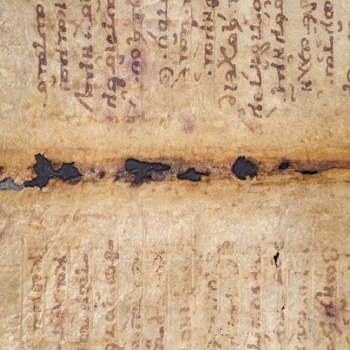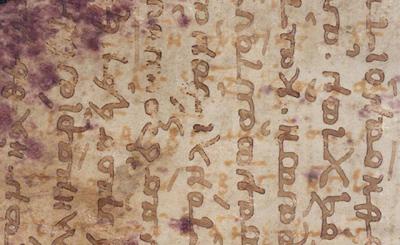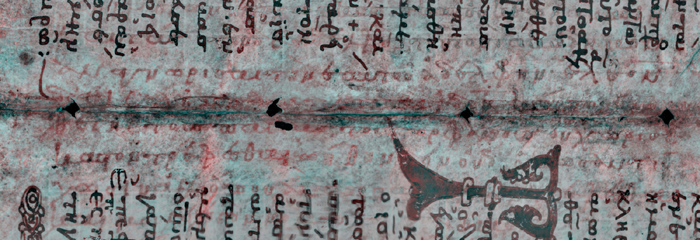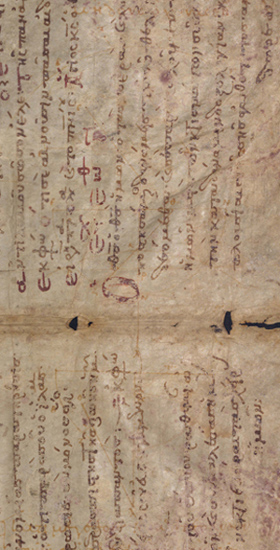Image Processing
If you look at things with different lights you see different things. It has long been known, for example, that we can retrieve under-drawings below paintings by looking at them in infrared light. This is because the carbon used by artists to make their under-drawing absorbs light at that range of the spectrum. On the whole, infrared light was not very useful in imaging the Archimedes Palimpsest (although there are one or two interesting exceptions in the non-Archimedes leaves), because the ink used by by the scribes did not have much carbon in it. Rather, the ink contained a lot of iron, and iron absorbs ultraviolet light. Ultraviolet light has often been used to look at faint text in medieval manuscripts, and it is extremely helpful in the case of the Archimedes Palimpsest.
These days, however, it is possible to post-process images to bring out more of what you want than is possible simply through image capture. And, of course, it is possible to use information from more than one image to do this. Keith Knox explains:
This pseudo-color technique that Keith developed is extremely useful. It is clever but it is not complicated, and it works well over the entire palimpsest. It is extremely powerful, and has been used to great effect. Here are a few examples.


These are before and after images of a detail of the leaf 105-110 of the Archimedes Palimpsest. The pseudo-color allowed Reviel Netz, Nigel, Wilson, Ken Saito, and Natalie Tchernetska to read Archimedes' Method Proposition 14 as never before, and come to a new understanding of Archimedes conception of infinity.


These are before and after images of a detail of the leaf 172-177 of the Archimedes Palimpsest. The pseudo-color allowed Reviel Netz, Nigel Wilson, and Fabio Acerbi to read Archimedes Stomachion as never before, and come to a new understanding of th role of Archimedes in the development of combinatorics in the mathematical tradition.


These are before and after images of a detail of the leaf 135-138 of the Archimedes Palimpsest. Pseudo-color images like this allowed Natalie Tchernetska to discover five leaves in the Palimpsest that do not contain writing by Archimedes at all, but rather otherwise unknown speeches by Hyperides, one of the ten canonical orators of antiquity.
Keith Knox's pseudo-color post-processing technique is but one of the ways in which the images can be processed. The imaging team also processed the same set of images to peel of the prayerbook text completely, and reveal the undertext alone. On the whole, the scholars seem to prefer the Pseudo-Color images to these pictures. But they do give very satisfactory images of the diagrams in the Palimpsest. This is important because the Archimedes Palimpsest is a unique source for the diagrams that Archimedes himself drew in the sand, in Syracuse, in the third century BC.


The post-processing possibilities on the images that the imagers have taken of the Archimedes Palimpsest have by no means been exhausted. Now that the images are online, anyone will be able to try their hand at improving on the legibility of the texts.